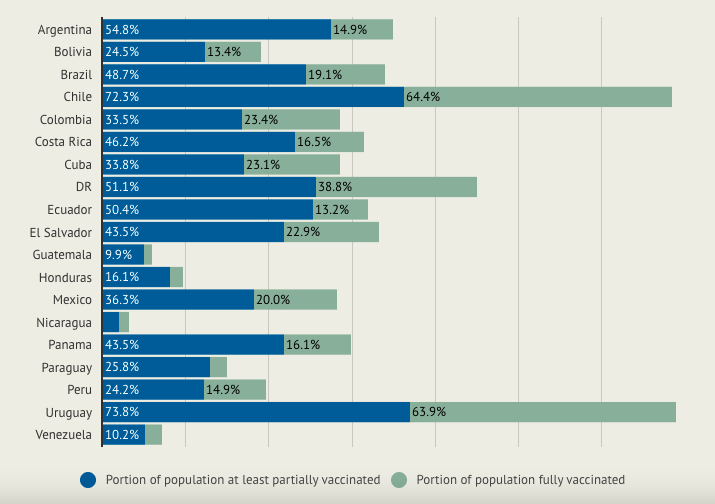Vaccine access in Latin America shows great disparities
While many higher income countries seemingly return “back to normal” while grappling with Delta and other COVID-19 variants, the rush to get everyone vaccinated is extremely apparent. However, the process is going very differently in every region, even every country. The global south’s vaccination rate lags significantly behind that of the global north. Regions such as Latin America are among the areas of the world that display extreme need for vaccines in large numbers as soon as possible. The Center for Systems Science and Engineering at Johns Hopkins University cites that as of July 22, 2021, eight of the ten countries reporting the highest rate of deaths per capita due to the Coronavirus are in the Latin America and Caribbean Region. The Council on Foreign Relations states Latin America makes up 35 percent of global COVID-19 deaths while only making up 8 percent of the world’s population.
However, even within the large region, there are vast disparities within how many are vaccinated in each country. The graphic below produced with research conducted by Americas Society / Council of the Americas shows the great variation within vaccination rates, specifically by how many have one vs. two doses, in Latin America.

Chile and Uruguay are the most protected countries as of now with 61.3 percent fully vaccinated in Chile and 58.8 percent in Uruguay. Amongst the lowest vaccinated countries are Guatemala, Honduras, and Nicaragua. Guatemala’s population is 1.4 percent fully vaccinated and Honduras’ portion of the population with both doses if needed is 0.8 percent. Nicaragua’s rate is so low that there is no data for fully vaccinated but we do know that at least 2.8 percent of the country’s population is partially vaccinated.
It is worth noting that in observing Latin America’s vaccination rates, all three of the countries doing the worst are in Central America. Central America is oftentimes ignored when it comes to thinking about Latin America in many senses. Oftentimes, the focus is placed on Mexico, Brazil, Argentina, Chile, Colombia, and other countries. However, this Central American erasure is partly a reason these countries experience some of the highest rates of poverty in the region which reflects when looking at their progress with vaccinations. The Northern Triangle especially has some of the highest poverty rates of the region and consistently faces a lack of focus and U.S. support. In an article by the Council on Foreign Relations, Avery Reyna cites Chile as the country in the lead and compares their rate to that of Argentina, Colombia and Mexico which is interesting considering countries in Central America are much worse off. The disregard for the extremely slow process in countries like Guatemala, Honduras and Nicaragua will only continue to keep this region among the most vulnerable to COVID-19 and impoverished.
The region’s delay in receiving vaccines for its people can be explained by its need to rely on attaining vaccines manufactured by outside countries. The director of the Pan American Health Organization, Dr. Clarissa F. Etienne, explains that the shortage of vaccines in this region is “a symptom of our region’s overdependence on imports for essential medical supplies. Less than 4 percent of medical products in use during the COVID response have come from the region.” Many Latin American countries have relied on vaccines from China and Russia (graphics below displaying which vaccines each country is acquiring). However, in some instances politics gets in the way of providing support to countries. For example, Brazil’s anti-China sentiment caused them to reject support for President Jair Bolsonaro to only reverse this decision as to secure more vaccines for his country that has been strongly hit by this virus. Within that, vaccines from China and Russia have both raised concerns from health experts about lower than expected efficacy rates. Bolsonaro even decided to ban the use of Sputnik from Russia due to these safety concerns.


Now, it seems like the best solutions to overcome vaccination challenges are to strengthen attempts to produce vaccinations domestically and/or acquire vaccines produced in the United States and Europe. Dr. Etienne sheds light on the necessary “building blocks” for the region to combat the lag in vaccination rollout. This includes expanding manufacturing capacity and regulatory systems significantly while continuing to listen to guidance from academic and research institutions. She states that it is important to commit to purchase regionally-made products as well as verifying that the products will not have trade barriers like export bans. This is a beneficial path forward for the entire region because “a regional manufacturing network that builds on [our] national strengths and that is backed by sustained financial commitments is long overdue,” as Dr. Etienne concludes.
While Latin America struggles to combat COVID-19 with a lag in vaccine access, this region is not the only one drowning in cases. The general trend is that countries made poor due to colonialism, resource extraction, and unfair lending practice resulting in fragile healthcare systems, now struggle with producing and acquiring vaccines. RESULTS recognizes the urgent need for action and has recently launched a campaign on Global Vaccine Access. While there is much work to be done, there are quick action steps we can all take to push forward this effort. In just 15 minutes, you can write a letter to the editor about global vaccine access. Similarly, another quick action is to write or call President Biden to encourage the administration to take a lead on this international effort. If you want to learn more about global vaccine access, check out the webinar from July 10 to be informed.